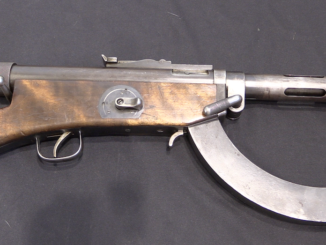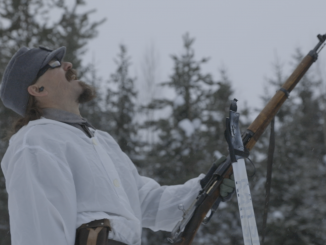After the Winter War and Continuation War, Finland settled a peace treaty with the Soviet Union, and started looking to modernize its infantry rifles – something semiautomatic was needed to replace the Mosin Nagants it was still using. A variety of rifles were tested, including the AR-10, Sig AM-55 (predecessor to the Stgw 57), and Madsen LAR. The Kalashnikov was really the clear choice, though, and the Finns received their first batch of Russian AKs in 1954. Sako and Valmet began working with AK designs in 1957, and by 1960 the Russian Type III milled receiver pattern was chosen as the basis for the new Finnish rifle.
That rifle would be formally adopted in 1962 as the Rk62, with full scale production beginning in 1965. It was mechanically a copy of the Kalashnikov, but with an assortment of external changes chosen by the Finns. Most significantly, the sights were dramatically improved. The front sight was given precise windage adjustment screws (as opposed to the Russian drift adjustments) and combined with the gas block. The rear sight was changed to an aperture type and moved to the rear of the receiver cover, which was also made with a much more precise fit than on Russian rifles.
The Finns also chose their own furniture style, including the distinctive tubular stock. While folding versions of this stock were sold commercially, the military pattern Rk62 used a fixed type, as does this M62/S semiautomatic version of the rifle. This example also has the early type of corrugated tubular pistol grip and “cheese grater” hand guard, both of which would be updated and improved after some time in Finnish military service.




Your basic universal infantry weapon, now with ergonomic upgrades and cheese! The hand guard lets air cool the barrel but how would it handle wear and tear from getting smashed into the environment?
Actually quite nicely, considering these were given to conscripts to throw around for years and years to come. I did my national service in the mid 2000’s and i clearly remember seeing one or two with grips just like in the video. Now if we could get a video of the RK62TP, with the abominable folding stock..
In my view, this is as good as military rifle gets. Finns demonstrated thorough understanding of this particular sort of equipment. No doubt, machined receiver is of paramount effect on a sturdy rifle, a point I dare to differ with conventional AK style rifle (and with all sheet metal receivers in general).
Only a small objection/ question I’d have, pending actual user’s experience, is outer size of peep ring. It seem to me unnecessary large in relation to aperture.
“machined receiver is of paramount effect on a sturdy rifle”
I must ask: why?
AK initially was stamped, which was later changed to milling, but it was due to limits of then used stamping technology and when it was “debugged” stamping technology was in use again.
Now I am specifically talking about AK type of design which includes this model and other derivatives. They have only ONE true receiver, e.i. the bottom part. This permits to use options in form of either stamped/ welded unit or machined one from billet while the latter method removes joints which would be source of lesser integrity. Continuous material is better than spot joint. We have one more option in addition of the two mentioned nowadays and that is precision casting; this method is taking hold lately (see latest HK rifle).
Back to stamped/riveted/welded assembly – it is the least desirable for sturdiness in long run. Look at slow motion video how is AK 47/74 receiver made out of 1mm medium carbon steel twisting and bending; it does not need much of comment. Yes, it is “good enough” but nothing more. You want to make it stronger? Sure, easy way is to use 1.5mm material… and weight goes up. Czechs in contrary used milled receiver in vz58 with no weight penalty. Convincing enough?
I would suggest t look how CZUB proceeded with their later designed rifles. They instead of fussing with stampings and going thru painful related issues went straight into old fashioned aluminum machined receivers. Result is not bad; namely that later iteration (so called Bren 2
https://www.czub.cz/en/produkty/automaticke-zbrane/cz-bren-2-8.html)
I do not say I like the rifle, just commenting on possibilities how to go about it.
Something about machining aluminum: it is awful noisy. I was working one time (luckily not for long) where they machined aluminum parts for aircraft manufacture. The noise it made is beyond description. But with some smaller rectangular bars and with plenty of coolant while part is well clamped it may not be that bad. Steel sheet pressing is not exactly treat to ear either 🙂
“specifically talking about AK type of design”
Ah, ok, so some misunderstanding here.
I was thinking about SVD https://www.syl.ru/article/200457/new_vintovka-dragunova-snayperskaya-vintovka-dragunova-svd
excerpt:
Приклад – жесткого, скелетного типа. Другой особенностью СВД является расположение предохранителя, а также ствольная коробка, изготовляемая простым и дешевым методом штамповки. От большинства аналогичных винтовок она отличается еще и штатным штык-ножом, идущим в комплекте с оружием. За все время эксплуатации солдаты однозначно указывали только на один недостаток – длину.
Stock – fixed [i.e. not folding], skeleton. Other trait of SVD is placement of safety and also receiver, produced by easy and cheap method of stamping. Unlike most analog rifles SVD was issued with bayonet-knife, as part of set. In all times of usage soldiers unequivocally pointed only one disadvantage – length.
Well, yeah I switched horses little bit…. first talked about pressed from sheet and fabricated receivers generally and then specifically AK. Sorry.
Well SVD would nor qualify as a standard ‘shturmovaya vintovka’ would it? Its weight unloaded starts at 4.3kg and can go all the way up to 5kg. With that amount of material you are bound to reach some strength. I should put it into prospective: it is higher end achievement to make solid rifle out of stampings, but it is possible. As anything in technology, it is matter of objective to reach the acceptable compromise.
But also, let me remind you of changing trend: latest rifles from K.K. are not stamped any more. I believe they call it Samozaryadnaya Vintovka Kalashnikov – SVK. Times are changing and with that way of thinking.
“SVK”
Now I confused.
This abbreviation was used for: https://ru.wikipedia.org/wiki/Снайперская_винтовка_Калашникова
which was competitor to Dragunov design, but it is sniper rifle Kalashnikov not self-loading rifle Kalashnikov
I was cosncript MP and stayed in the service for a good part of 5 years. Never had a problem with he RK. Neither with the fixed stock or folding srock variery. Only probs we had came with the old type metal magazines as these were prone for denting. When the plastic wonder replaced these, feed problems dissapeared. It was an accurate rifle to shoot up to 300m and even further.
High speed footage of AKs firing shows the gas block moving slightly forward causing the barrel to droop. The equal and opposite reaction to the piston moving rearward. A closer analysis shows the piston pitching upwards due to the torque produced by the vertical offset of the force and center of mass. This pushes upwards on the gas tube. The Finns seemed to have been concerned about this and developed the slots and grooves to stabilize the rear of the tube. Also the star shaped collar machined into the piston rod shortens the lever arm pushing up on the gas tube. IMHO.
You are spot on and this is what I am talking about in my previous note (response to Daweo).
I think you are correct in saying the Finns understood this gun. They understood the Mosin also, notably to this day. The success of the AK speaks for itself, but there is nothing wrong with a little tweaking. Mr. K got it right, but not totally, 100%, absolutely right.
“success of the AK speaks for itself, but there is nothing wrong with a little tweaking. Mr. K got it right, but not totally, 100%, absolutely right.”
Indeed; If AK would be ultimate, then AKM would never appear.
Supposedly gas piston needs to have some play, builders from us who fixed them (screwed all the way and pinned) reported Ak turning into jamomatic.
It seems like it is case hardened along with b.carrier ? (Bolt looks chromed)
I wonder why there never was an attempt to make Ak receiver longer and place sights on a fixed point at the end, similar to arrangement Uzi has (with top cover in between). Not only would that help with sight wobble but would also lower the rate of fire and prevent additional recoil from bolt carrier hitting the end of the receiver, somewhat of a “constant recoil” principle.
Its interesting that the feature of the AR18 that Sullivan got a patent on, was a ball joint between the actual gas piston and the operating rod.
The AK and the AR18 take very different approaches to gas operation
With the AK using a relatively rigid tube with the piston permanently attached, and a “long stroke” gas system
The AR18 using a short stroke gas piston and a very skinny and flexible operating rod, with the ball joint to accommodate misalignment
A few comments, if you please.
Instead of the Russians and instead of 1954 the first 101 AK assault rifles to arrive in Finland were of Polish origin and manufacture. The first example was clandestinely brought into the country in 1956 and a batch of 100 pcs was bought in 1957. The first Soviet-built AKs were bought from the USSR in 1960 at a price of 387 rubles per rifle. The deal included 20 000 rifles with wooden stocks and 1000 with folding metallic stocks.
You also forgot to show the rear night sight which is of the notch type with two illuminating circles, one on either side of the notch. You’ll find the sight by flipping the rear sight tanget 180 degrees forward.
The Finnish military had and still has both folding stock and stamped receiver versions of the RK 62. The first series-produced folding-stock rifles, called RK 62 TP (TP = taittoperä, folding stock) were acquired in the mid 1980’s. Exact production numbers are unknown, but they are in the thousands in any case. As to the stamped receivers, the Valmet factory produced its RK 62s for the Finnish military exclusively with stamped sheet metal receivers from 1977 to 1982 and then swithced back to milled receivers.
Sources:
Приложение 1 к Контракту № 0163 от “22” июля 1960 года. Военно-технического имущества, поставляемого Министерству обороны Финляндской Республики в 1960-1961 г.г.
Palokangas, Markku (1988): Sotilaskäsiaseet Suomessa 1918-1988, 2 & 3.
To LV’s notes: The rear night sight is hiding under the regular one – just flip the rear sight tangent forward 180 degs and it turns to night use. Night sights are small tritium “lamps”. There is/was a batch of military RK62’s without night sights. Tubular stock is also storage for cleaning rod (in three parts), plastic oil bottle and tool for adjusting sights. There is a lid in the end of stock which flips sideways to open/close.
iThe Puukko style Bayonet for the Valmet 62/s was very distinctive. Mikko Hiltunen posted this link to show it : http://www.jaegerplatoon.net/bayonet_m62.jpg The bayonet is distinctive because it has no cross guard and it is a Very sharp knife. When these Valmet 62/s rifles were for sale new I saw one in a Milwaukee gun shop. The rifle was on a floor rack with the bayonet attached but it was heavily taped to the barrel with black electrical tape. I of course inquired why the tape job. I was told that an earlier customer had pulled the sheath off and had sliced his pointer a and second finger joints very deeply requiring surgery. They said the tape would only be removed after the new owner who ever was, was warned of the real danger of the Sharp Puukko bayonet.
Yikes! I am certain that nobody should try the movie approach of disarming a rifleman, which consists of grabbing the barrel when it pokes past a doorway or around the corner. Someone mentioned this during a discussion of trench fighting with combat shotguns…
Of course the Finns would issue a puukko-style bayonet: those little knives are an essential body part in Finland. A fighting knife? Well, not really, but good for everything else. (Nothing will part me from my Tapio Wirkkala model, I don’t care how much they go for on the rarities market.) And of course the Finnish army issued them sharp, because the soldiers would mutiny if they didn’t — and then whet them by hand anyway.